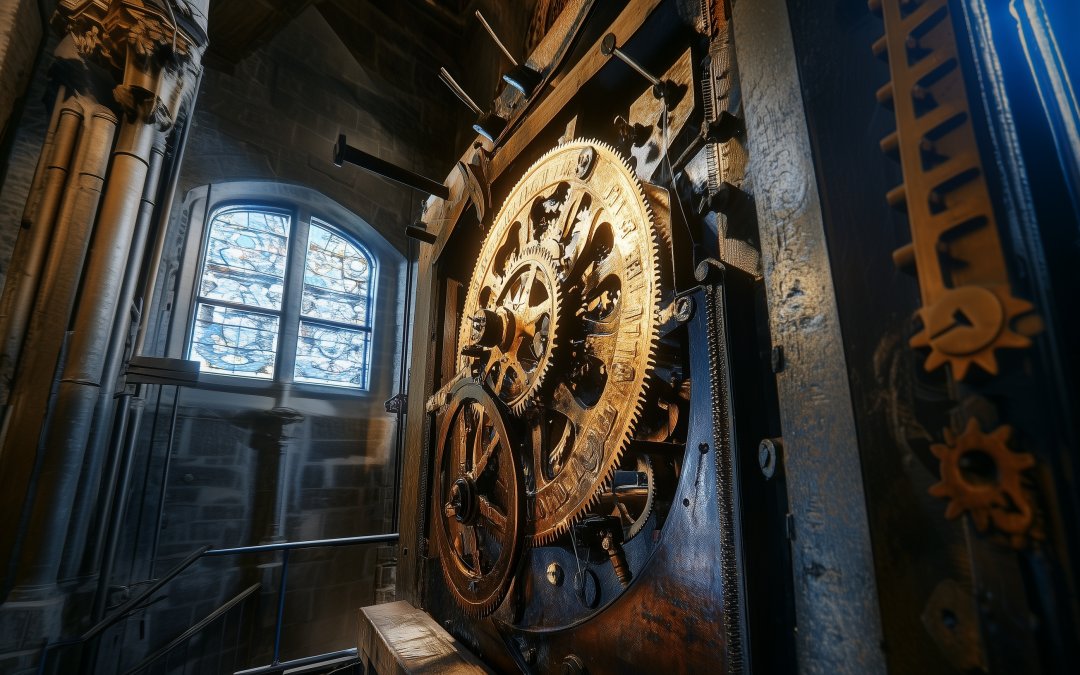Explore the fascinating ways Guardian City marks time, from the Rift’s mysteries to rebellious timelines defying London’s dominance.
It’s a new year in Guardian City. While London marks 2025 in Parallel Time, it’s 1875 in Obscure Time. So how come there are two time labels? What is it with Guardian City and time?
From debates over backwardness to alternative systems that challenge London’s dominance, here are five fascinating facts about how Guardian City marks time.
1. The Rift and the Start of Obscure Time (OT)
When Guardian City emerged from the mysterious Rift in 1666, its residents began counting years from the timeline they remembered even though no-one knew exactly how long before they had been lost in the Rift – was it milliseconds or centuries? No-one knew exactly what might happen when Isaac Newton tinkered with the mudge levels in the Thames.
When London and Guardian City found a way to contact each other, through the Quarrel, there seemed to be some synchronicity, but London didn’t like the idea of Guardian City, virtually a penal colony in its eyes, being on a par with their global city.
2. The Controversial Book of Parallels and the Year 1701
The Book of Parallels, published in 1705, repeated the argument that Guardian City developed more slowly than London due to its smaller population, less advanced infrastructure, and weaker division of labour.
At the 1701 Conference of Parallels, attended by luminaries like Isaac Newton, a formula was developed to re-calibrate Guardian City’s calendar. The result? A 150-year adjustment that institutionalised the idea of Guardian City’s “backwardness.” While the move aimed to provide clarity, it instead sparked a deep cultural rift between those who accepted London’s dominance and those who resisted it.

London’s timeline, referred to as Parallel Time (PT), continues to run as if Guardian City were never severed by the Rift. Today, the year in London is 2025 PT, but in Guardian City, it is 1875 OT.
This difference reflects the contentious recalibration of 1701 and serves as a reminder of the divide between the two cities. For some, the disparity fuels a sense of inferiority and the ongoing quest for Guardian City to “catch up” to London.
3. Tempus Obscurum: A rejection of London’s authority
Some groups in Guardian City, like the Tamasene and the Anti-London League, reject the concept of both Obscure Time and Parallel Time. Instead, they use a system called Tempus Obscurum (TO). This alternative timeline highlights their independence from London.
For example, in Tempus Obscurum, the current year is written as 6.358. The “6” refers to an estimated 6,000 years since the Braccans’ arrival on Earth from the Procul system, known as the “Origin Date”. The “358” counts the years since the Rift of 1666, making it their Year Zero. Tempus Obscurum reflects a refusal to acknowledge London’s influence over Guardian City’s timeline.
Use of Tempus Obscurum is illegal and only mentioned here “for educational purposes”.
4. Calls for a new conference to re-synchronize calendars
In 1875 OT, it is 170 years since the publication of the Book of Parallels which governs how London and Guardian City do business and conduct bilateral relations. A lot has changed in that time and Guardian City in outlook is more in tune with modern London than ever.
Activists say it is time to scrap Obscure Time and its inherent prejudices and stereotypes.
Even the Obscure Trading Company, despite its typically pro-London stance, has expressed sympathy for recent calls to re-synchronise the Guardian City and London calendars. Critics of the 1701 decision argue that the recalibration entrenched an unnecessary sense of inferiority.
Advocates for a new conference believe that aligning the calendars could foster a stronger sense of equality and shared purpose between Guardian City and London and make Convergence a more realistic possibility. It is unlikely to happen and neither the Shimmerings Parliament or the Council of the Invisible have plans to discuss any change.
5. Why time looks backwards – and forwards
Mudge is a time particle. The second earth of the Commonwealth was born out of a time spin-off. Guardian City’s approach to timekeeping is more than just a chronological system – it’s a reflection of its history, cultural identity, and ongoing struggle for sovereignty, hence the grandeur of Time Plaza and the dominance of the Grand Regulator – Big Reg – as the tallest working structure in the city.
Beneath the mechanical ticking of the clock is another kind of time. The time of waiting. For the Orphans of the Rift, separated from their families, properties and birthrights on the old planet, they see a time of Convergence. Time marches at a stately pace, counting down to the moment of reunion.

